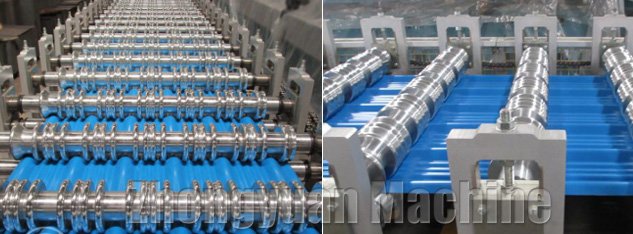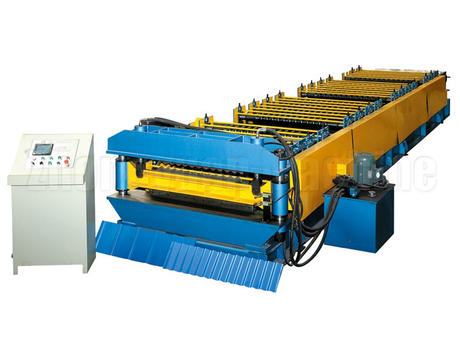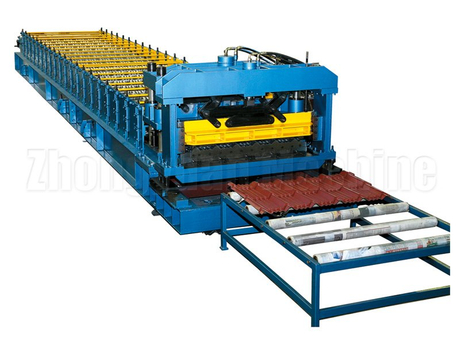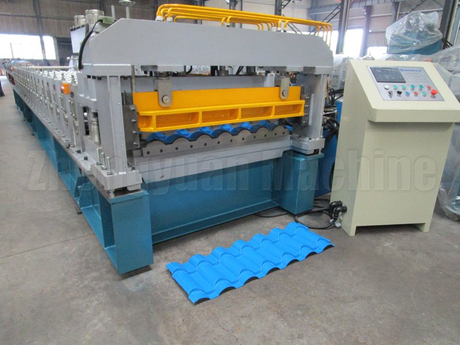Deciding on a way to shape metal for your next manufacturing project can be a lot of work. First and foremost quality is paramount, but it is also essential to keep costs low. If you are discussing the benefits of either roll forming or press braking for your next metal fabrication project, there are a couple of factors to consider.
![Roof-tile-roll-forming-machine]()
In the end, the decision comes down to which fabrication method yields the ideal quality at the lowest total cost. This article is designed to help you make the right decision for your next project.
What is Roll Forming?
Roll forming is a type of metal bending consisting of continuously rolling long strips of sheet metal that is bent to a required cross-section. The sheet metal passes over a set of rolls usually mounted on two stands.
Each group of rollers carries out an increasing portion of the bending until the desired profile is achieved.
Roll forming is a simple process that can yield complex shapes. It is typically a cost-effective and responsive alternative to press brake and punching.
What is Press Braking?
Press braking is a metal distortion process that aligns a sheet of metal along an axis. This is accomplished by clamping the sheet metal between a punch and a die set with a press brake to make a pre-arranged bend.
Press braking ensures accurate metal bending of several types of parts. The pressing process can make a variety of shapes, some of the most common shapes are 90° ribbed, V-bottom, channel, closed, double form, cap channel, offset, open cap channel, etc.
4 things to consider when choosing between roll forming&press braking
![Roof Forming machine]()
1. Length
Like stamping, press braking does not allow for long parts to be made. Longer parts require a secondary operation to connect a couple of smaller pressed parts. This adds cost through fasteners and labor, and increases product weight.
The major difference between roll forming and press braking is the way the material is supplied. Pressed material must be sheeted, slit and cut to length before it can be inserted into the press, which can add to the cost.
Slit rolls can be fed directly into any roll forming line. longer parts can be made without the use of fasteners and generate less scrap. Thus, production is more efficient, with less waste and more cost-effective.
2. Materials Selected
The materials used are also another key factor to consider. Material selection will affect cost control and product design, and then influence which manufacturing process is most appropriate.
Roll forming and press braking are most effective for lighter materials. High-strength metals may be hard to use with these two technologies. Technically, the use of high-strength metals is still achievable, as there are techniques to compensate for rebound. However, these techniques require additional labor and increase expenses.
Therefore, in any case, we recommend that you choose a durable, lightweight metal for roll forming and press braking.
3. Fabrication Design
The design you expect will also influence the compatibility of these two methods. Press braking and roll forming employ different processes, each differing in the amount of time required to finish complex bends and shapes.
For instance, press braking could only address a certain number of bends. In addition, each bend needs to be passed through the machine individually. Due to this one-strike process, more complex forms require a longer time to produce. This may delay production and add to labor costs.
In contrast, roll forming allows complex shapes to be formed in a single process, thus simplifying the production process. A single roll forming machine can create almost any linear shape you want. This eliminates the need for multiple tooling steps in the manufacturing process. So, although the design is complex, you can cut production and labor costs with roll forming.
4. Tooling Costs
The tooling costs for press braking and roll forming are typically quite similar. There are, however, differences based on some specifications of a certain project. The general rule of thumb for roll forming is the larger the volume of the product, the lower the tooling cost per piece.
If the run time is short, or the production volume is low, then the press mould will have a lower cost per piece than roll forming. You have to first decide on the volume of your metal project in order to precisely compare the tooling costs between the two.
Conclusion
For your decision to use a roll former or a press brake, carefully weigh the several factors mentioned above. Both methods have obvious pros and cons. The decision will be easier to make if you work with a reliable manufacturer who can help you design and execute your metal product.
Talk to a Zhongyuan engineer to get advice on your sheet metal application needs. The best answer to your sheet metal roll forming questions can be provided.
Contact Zhongyuan's experts today to get the best return on your investment!
 English
English










